
(Atomic energy , internal energy of atomic nuclei
which evolves from nuclear transformation (nuclear reaction). Nucleons
(protons and neutrons) are kept together by strong nuclear forces.
To take out a nucleon from the nucleus it's necessary to do much
work, i.e. impart considerable energy. Nuclear binding energy is
energy which is necessary to completely split a nucleus into separate
nucleons. According to the energy conservation law we can state
that the binding energy is equal to energy which evolves when a
nucleus forms from separate particles. Binding energy of atomic
nuclei is much greater than the binding energy of electrons and
an atomic nucleus. It's possible to find nuclear binding energy
if you know a mass of the nucleus and masses of the particles -
protons and neutrons which it consists of...
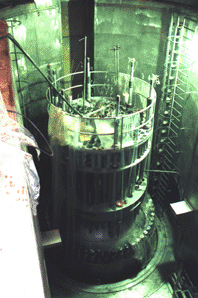
The most stable are nuclei which have the greatest
binding energy density, i.e. iron (Fe) and chemical elements of
the periodic system which are close to it. The binding energy of
light elements increases as the atomic number grows because the
most part of nucleons are at the periphery. Each nucleon interacts
with just a small number of its neighbors because of the short-range
nuclear forces, and the less the mass number, the less the number
of nucleons which take part in the normal nuclear connection with
its neighbors. The binding energy density of the heavy nuclei decreases
as the atomic number grows because the energy of proton repulsion
increases which means that such nuclei are relatively unstable.
Their split-up is profitable from the energetic standpoint. Usage
of nuclear energy is based of chain fission reactions of

heavy nuclei and nuclear fusion reactions -
fusion of light nuclei; both reactions are followed by energy liberation.
Well, this is what the word Chaintech is all about.
So, what such chain technologies can offer today?
A modern nuclear power plant is a complex of
a great number of interconnected facilities. The main element of
the NPP is a power unit containing a nuclear reactor which heats
up water.

That is why the building units must meet the
strict requirements of reliability. In particular, the facilities
and the building can stand an earthquake of 7 numbers.

A controlled nuclear chain reaction followed
by energy liberation is carried out in a nuclear reactor. The main
parts of the nuclear reactor are: an active zone which contains
nuclear fuel and where chain nuclear fusion reactions run and energy
is liberated; a neutron reflector which surrounds an active zone;
a heat-carrier; a chain reaction control system, and radiation protection.
The people you can see on the power unit are not
suicides, they are just standing on the unfinished power plant.
Almost everything in the IT technologies is based
on the chain principle. Stages, pipelines, regulated sequences of
operations. That is why the name of one of the largest companies
is justified. We studied products of this Taiwanese company, which
is already 15 years old, a lot of times. Its video cards are mostly
based on NVIDIA processors. Unfortunately, for almost a year the
company dropped out of sight for users of GeForce2 Ultra and GeForce3
cards. And only by the end of 2001 the company released models on
the GeForce3 Ti 200/500 (including samples with 128 MBytes memory)
and junior models on the GeForce2 Ti. Lately we have tested its
GeForce4 MX 440
cards. And today we are going to estimate a flagship of the modern
market of 3D accelerators - a GeForce4 Ti 4600 card.
First of all, take a look at the articles related with the GeForce4
Ti line.
Theoretical materials and reviews of video cards which concern functional
properties of the NVIDIA GeForce4 Ti GPU
The GeForce4 Ti 4600 card from Chaintech has two versions: A-GT60 and A-GT61
SE which differ in cooling devices (the latter has copper and more luxurious
coolers), and in packages (the SE's one looks better). Today we will take
a look at the SE version.
Card
The Chaintech A-GT61 SE has an AGP x2/x4 interface, 128 MBytes
DDR SDRAM located in 8 chips on both sides of the PCB.
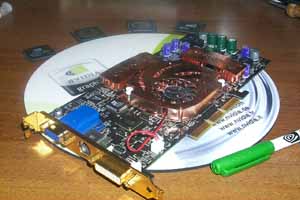


The Samsung 2.8ns memory chips correspond to 357 (714) MHz. The memory
works at 325 (650) MHz.
It's the first time when a video card has chips with a new BGA package.
That is probably why the memory works stably at its rated frequency even
without being cooled (for example, on the GeForce4 Ti 4400 cards the 3.6ns
memory works at the rated speed of 275 MHz). However, this time the engineers
played safe and decreased the speed by 30 MHz. The chip works at 300 MHz.
Chaintech A-GT61 SE with cooler

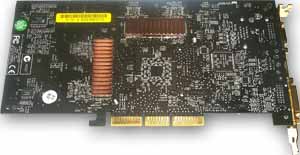
Chaintech A-GT61 SE without cooler

NVIDIA GeForce4 Ti 4600
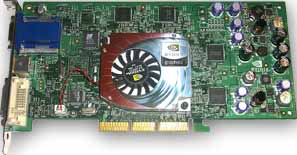

The card has a completely reference design. Let's take a look at the cooler
which is a soap-box of all card makers.
Chaintech left the same contour of the central heatsink, but it made
it of copper. This shining cooler looks like a piece of art as the company
used here embossing and figured carving.

The design of the heatsink is standard for GeForce4 Ti cards: this is a
box closed at two sides whereto a fan drives air which as a heavy flow
passes over the GPU.

A cooper heatsink must help much overclocking of a chip and memory, but
we will touch upon it later.
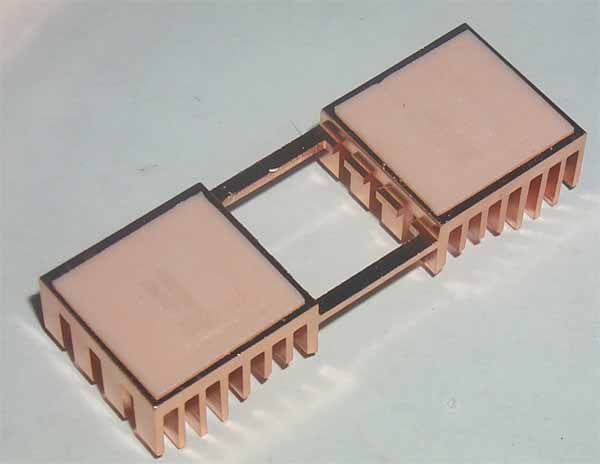
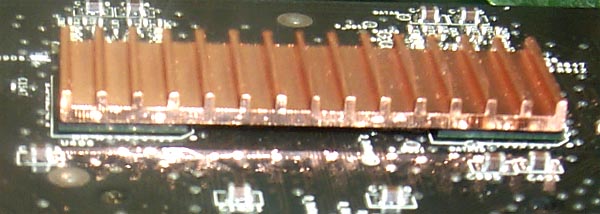
The heatsinks of the memory consists of two sets: the larger
one has two pin heatsinks (of the same form as of the Gainward
cards); and the smaller one has two plate heatsinks. Each heatsink
covers two memory chips. Note that the memory chips located on the
front side are better cooled as the heatsinks are higher and there
is the central cooler. That is why if you are going to overclock
the card, you should provide additional cooling.

It's interesting that all chips we see on the production cards have codenames
(not full ones - GeForce4 Ti), and the processors are produced quite long
ago (end of 2001 - beginning of 2002). Here it's all the same:
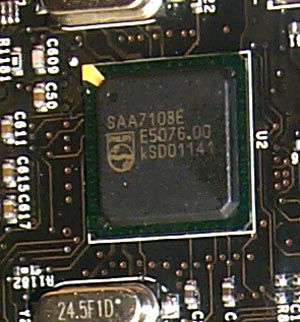
The Chaintech A-GT61 SE card comes with a codec which controls VIVO
(Video In, Video Out). Traditionally, all NVIDIA's GPUs based cards have
a processor from Philips (DAC-ADC). In our previous reviews we can find
detailed information on the Video In based on the Philips 7108.
Note that such long cards which have many capacitors in its
tail part can be incompatible with some mainboards, in particular,
with the EPoX 8KHA+ (see the details in the MSI
GF4Ti4600 review). Besides, there can be problems with i815E
based boards, for example, with Chaintech 6OJV2.
The Chaintech A-GT61 SE has three connectors: VGA,
DVI and TV-out (see the details here).


The card ships in the Retail package which includes:
- user manual;
- 3 CD with software:
- drivers and utilities (including a DVD player and TurboGFX utility);
- AquaNox game;
- MDK2game;
- S-Video extender;
Unfortunately, a VIVO adapter-splitter is lacking, that is why we couldn't
examine this function.
Overclocking
Apart from the drivers (ver.27.20/Win9x and 27.30/WinXP) there
is a utility of settings and overclocking - TurboGFX. Unfortunately,
it doesn't work correctly with the GeForce4 Ti 4600 card (it shows
twice lower frequencies and is nearly useless for overclockers).
The tested card works stably at 325/375 (750) MHz, which is almost as
much as the Gainward reached (however, Gainward selects chips only with
a good overclocking potential for the Golden Sample line, while Chaintech
installs any chips). That is why the copper cooler helped a little.
Note:
- in course of overclocking you must provide additional cooling, in particular,
for the card (first of all, for its memory):

Though this is not necessary here because the huge heatsink can cool down
the card effectively even at such frequencies.
- overclocking depends on a definite sample, and you shouldn't generalize
the results of one card to all video cards of this mark or series. The
overclocking results are not the obligatory characteristics of a video
card.
Test system and drivers
This time we estimated how the accelerator's performance depended on a
CPU frequency (and on a platform), that is why we used several testbeds:
- Athlon XP 1666 MHz based computer (2000+):
- AMD Athlon XP 2000+;
- EPoX 8KHA+ (VIA KT266A) mainboard;
- 512 MBytes DDR SDRAM PC2100;
- Fujutsu HDD, 20 GBytes;
- Windows XP.
- Athlon XP 1250 MHz based computer:
- AMD Athlon XP 1250 MHz (100 MHz x 12.5)
- EPoX 8KHA+ (VIA KT266A) mainboard;
- 512 MBytes DDR SDRAM PC2100;
- Fujutsu HDD, 20 GBytes;
- Windows XP.
- Athlon 1000 MHz based computer:
- AMD Athlon 1000 MHz (133 MHz x 7.5)
- ABIT KT7E (VIA KT133A) mainboard;
- 256 MBytes SDRAM PC133;
- Fujutsu HDD, 20 GBytes;
- Windows XP.
- Athlon 750 MHz based computer:
- AMD Athlon 750 MHz (100 MHz x 7.5)
- ABIT KT7E (VIA KT133A) mainboard;
- 256 MBytes SDRAM PC133;
- Fujutsu HDD, 20 GBytes;
- Windows XP.
The test system was coupled with ViewSonic P810 (21") and
ViewSonic
P817 (21") monitors.
In the tests we used NVIDIA's drivers of v28.32. VSync was off,
S3TC
was off.
For the comparative analyses we used the following cards:
- ABIT Siluro GF3 Ti500 (NVIDIA GeForce3 Ti 500, 240/250 (500) MHz, 64 MBytes);
- ATI RADEON 8500 (RADEON 8500, 275/275 (550) MHz, 64 MBytes, driver 6.052);
- Joytech Apollo Devil Monster II RADEON 8500 (RADEON 8500LE, 250/250 (500)
MHz, 128 MBytes, driver 6.052,
o/c 275/275 (550) MHz).
Test results
The 2D quality is the same as of the reference card, no problems
up to 1600x1200@85 Hz. The dual-monitor support was already estimated
here.
For estimation of 3D quality we used:
- Serious Sam: The Second Encounter v.1.05 (Croteam/GodGames) - OpenGL, multitexturing,
Grand Cathedral demo, test settings: quality, S3TC OFF, Trilinear;
- Return to Castle Wolfenstein (MultiPlayer) (id Software/Activision) - OpenGL,
multitexturing, Checkpoint-demo,
test settings - maximum, S3TC OFF, the configurations can be downloaded
from here.
Serious Sam: The Second Encounter
The tests were carried out in a 32-bit color mode.
1024x768

The processor affects the performance much in this test, and even at 1250
MHz it is a bottleneck for the Ti 4600 (there is no difference between
the Ti 500/Ti 4400/Ti 4600). Only the ATI cards perform worse on the junior
processors.
1280x1024
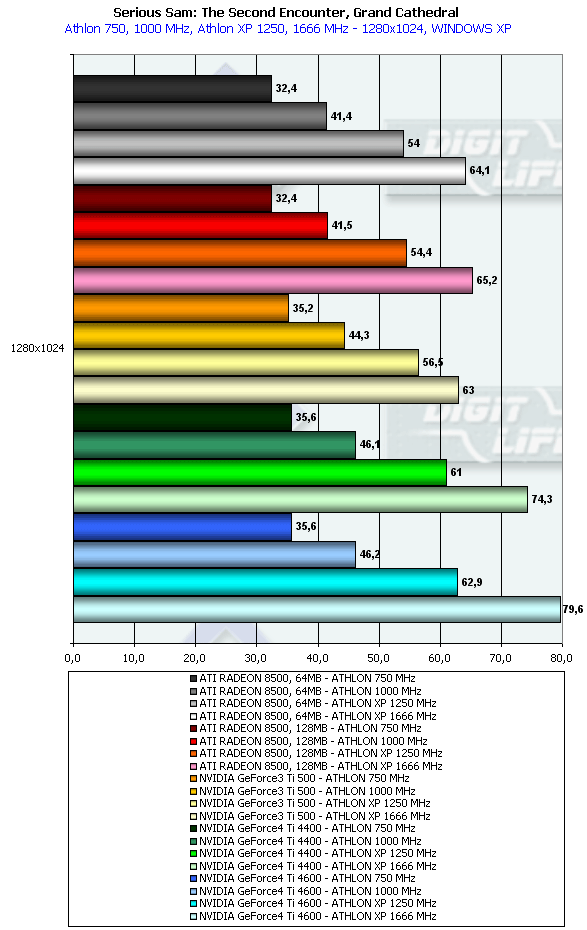
In this resolution the bar was lowered from 1250 to 1000 MHz, i.e. the
AthlonXP 1250 MHz is still able to show that the Ti 4600 is the fastest
card :-).
1600x1200

In this resolution the performance does drop when the CPU transfers to
1 GHz, but it makes no sense to estimate the differences because of the
playability of the junior processors.
Summary

This test shows that Ti 4600/4400 cards must be coupled with processors
working at least at 1.5 GHz. Do not use Ti 4400/4600 cards on old platforms:
a system unit must be balanced! If you want a very powerful video card
you
should upgrade your processor and/or platform!
Return to Castle Wolfenstein
The tests were carried out in 32-bit color mode.
1024x768

This game depends much on the processor in this resolution. The performance
drop of different cards is completely on account of the CPU and platform.
The cards are so powerful that even 1666 MHz of the AthlonXP can't enable
their potential completely.
1280x1024
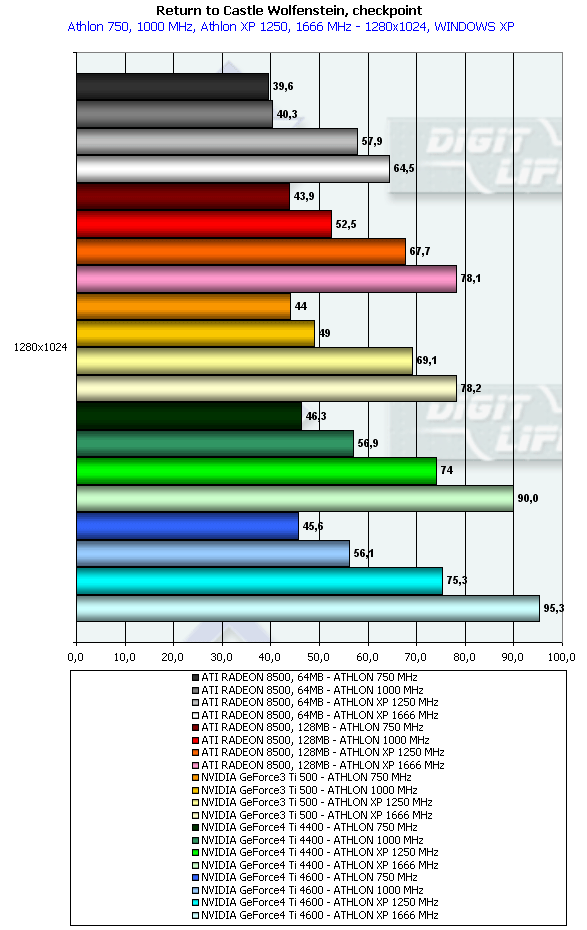
Here the fastest AthlonXP helps the Ti 4600 win, and even 1250 MHz do not
holds back the GeForce4 Ti considerably, though the Ti 4400 and 4600 are
very close in speed.
1600x1200
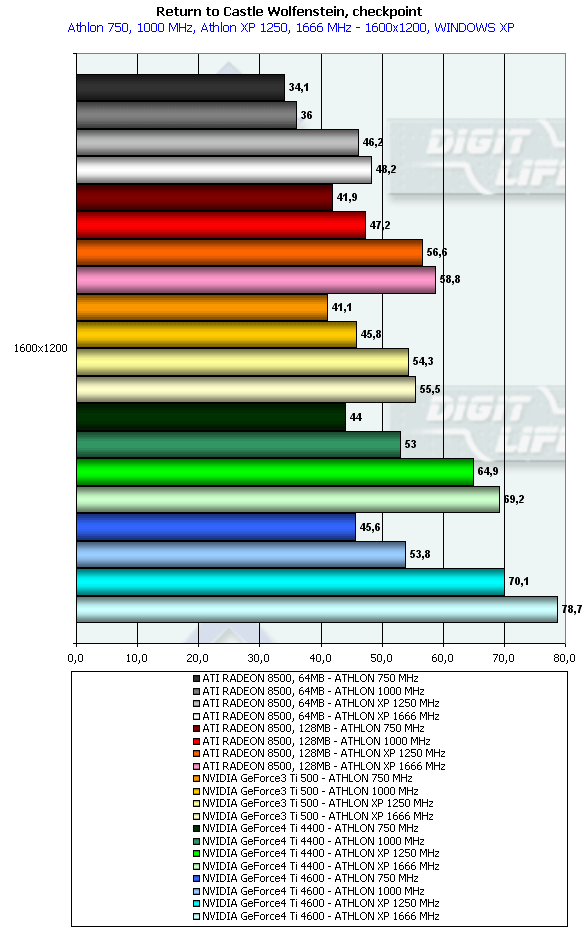
The situation is close to the previous test in this resolution. The potential
of the Ti 4600 and Ti 4400 is shown in full only at 1666 MHz, and the slower
CPUs restrain the cards.
Summary

Well, a platform must be well balanced.
In closing, I'd like to recommend you to read our 3Digest
where you can find detailed information on performance of these
cards on different platforms.
Conclusion
We have tested one more video card on the GeForce4 Ti 4600 in different
applications and on different platforms. Next time, in a review on another
GeForce4 Ti card, I will speak about scalability of systems based on Intel's
platforms and we will extend the list of tests.
The Chaintech A-GT61 SE is an excellent product. Taking into account
its design and package, its price seems to be quite low - $380 by retail.
Highs:
- High quality of the tested sample;
- Excellent performance in 3D;
- Full support of all DirectX 8.0 functions and a partial one of the DirectX
8.1;
- Effective cooler made of copper heatsinks;
- Beautiful appearance;
- Excellent Retail package.
Lows:

Write a comment below. No registration needed!
